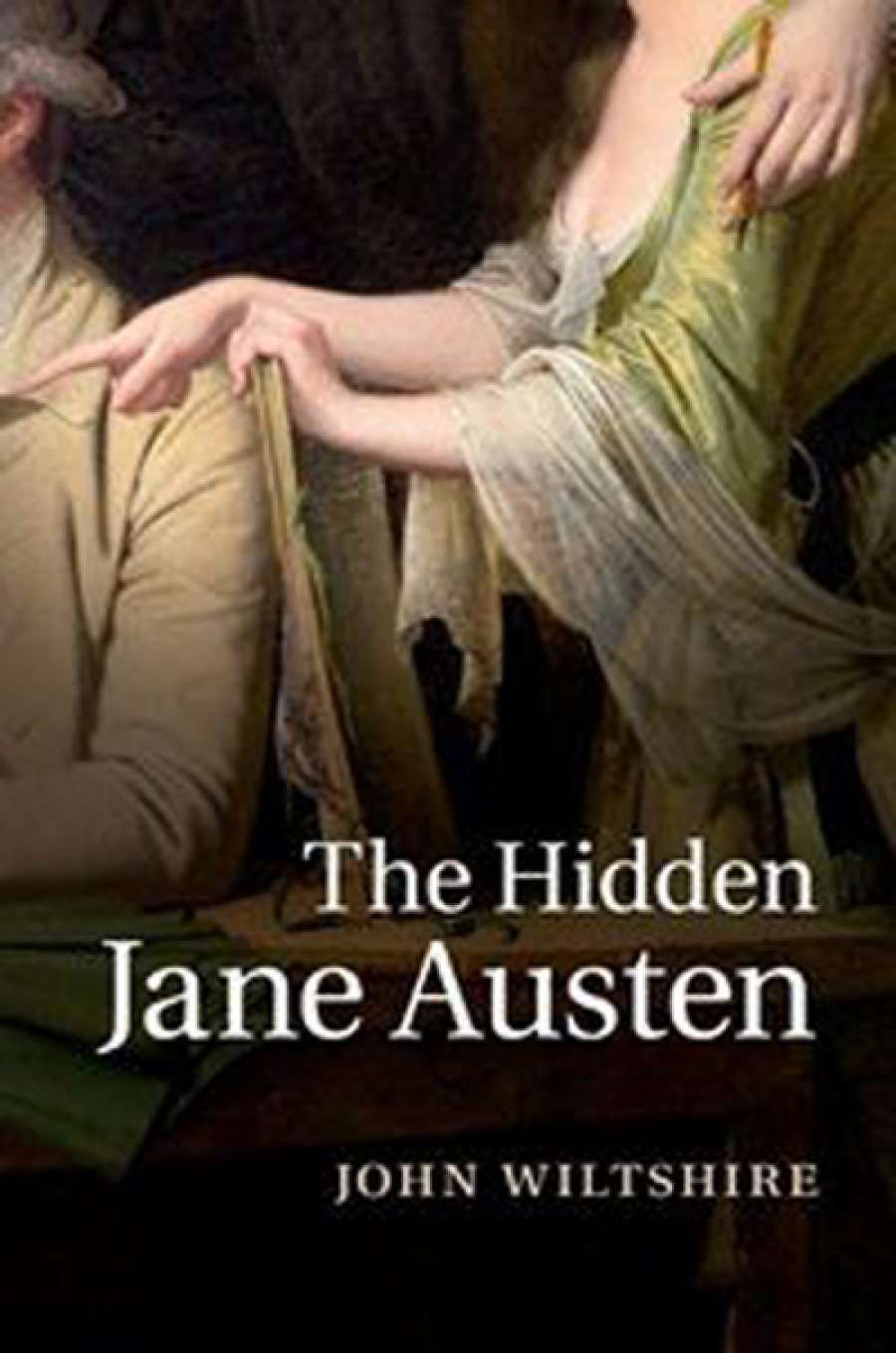
- Free Article: No
- Contents Category: Literary Studies
- Custom Article Title: Penny Gay reviews 'The Hidden Jane Austen' by John Wiltshire
- Book 1 Title: The Hidden Jane Austen
- Book 1 Biblio: Cambridge University Press, $44.95 pb, 207 pp, 9781107643642
Austen’s community was more overtly gender- and class-bound than ours. In Sense and Sensibility’s three volumes, Austen delineates the men’s ‘hidden lives’ and the women, ‘condemned to concealments’. Wiltshire sees in Elinor’s encounters with Lucy Steele a well-developed ‘anger’ and ‘sarcasm’, ‘the expression of what genteel social life compels her to conceal’. It is salutary to be reminded of this ‘regulated hatred’ aspect of Austen’s writing, though as a reader I find myself more engaged by the profound depths of her portrayal of sisterly love. Both themes, however, are arguably more powerful than the sisters’ various romantic anxieties over the unsatisfactory Edward Ferrars and Colonel Brandon. Rom-com this novel is not.
Pride and Prejudice is romantic comedy, at least as far as modern adaptations are concerned. But for Wiltshire it is a psychological novel; he sees its ‘understanding of memory formation’ as extraordinarily prescient of modern theories of cognition (or, indeed, prejudice). Wiltshire’s focus on memory explains the particular satisfaction afforded by the novel’s two late chapters of dialogue between Elizabeth and Darcy, in which they ‘actively and tenaciously retrieve the past’; Elizabeth asking, ‘Did you admire me for my impertinence?’, and Darcy replying, ‘For the liveliness of your mind, I did.’ It is not just a compliment; it is a truth shown in Austen’s manipulation of the romance genre.
Understandably, it is with the novel he edited for Cambridge University Press, Mansfield Park (1814), that Wiltshire’s methodology provides the greatest insights. Two chapters of this new book are barely enough for him to demonstrate the intimacy of his acquaintance with what he rightly calls ‘this magnificent novel’. The first is titled ‘The Religion of Aunt Norris’: it expounds the way the tyrannical Mrs Norris’s mind works as she tries to negotiate her own unrecognised resentments. Wiltshire’s emphasis on the theme of ‘the self-knowledge that both Enlightenment ethics and Anglican theology concurred in believing was the goal of the moral life’ is very helpful both here and in the later novels: ‘the promotion of self-review and the scrutiny of one’s treatment of others’ becomes a yardstick. We see, in Fanny, not just a ‘Christian heroine’ (as much critical literature tries to define her), but one who ‘asks [herself] for guidance’, based on her individual reading and thinking.
 Jane Austen by Cassandra Austen, 1810 (http://www.janeausten.co.uk/ via Wikimedia Commons)
Jane Austen by Cassandra Austen, 1810 (http://www.janeausten.co.uk/ via Wikimedia Commons)
It is not that Fanny is perfect – far from it; she has to try and hide from herself the depth of her desire for Edmund – but she is more interesting, morally, than the vivacious socialite Mary Crawford or the temporarily reformed seducer Henry. Wiltshire’s chapter ‘The Story of Fanny Price’ recalls the psychological trauma she has suffered as a child – taken from her family, dumped in the middle of an alien great house and its population, and ignored by all but her cousin Edmund. Wiltshire draws powerfully on twentieth-century narratives of childhood displacement: the Stolen Generations, and the British children from poor homes sent out to the colonies to make a new start. It might be suggested, he writes, ‘that the travails of emigration and displacement are conditions of a modernity whose narrative history began in Jane Austen’s time. The currency of such stories now enables us to read Mansfield Park as their precursor.’
‘Wiltshire draws powerfully on twentieth-century narratives of childhood displacement: the Stolen Generations, and the British children from poor homes sent out to the colonies to make a new start’
Fanny’s enforced return to her original family home at Portsmouth offers Wiltshire the opportunity to discourse, brilliantly, on Austen’s use of the complex word ‘comfort’: for Fanny, he argues, ‘it is a compromise formation … between desire and actuality, the second-best runner-up to happiness’. This ‘compromise’ inflects even the novelist’s genre-determined ending. I don’t think I have read a more astute commentary on Austen’s strategy in its famous last chapter – from its narrator’s opening promise of ‘tolerable comfort’, its ‘defensive, uneasy irony’ about romantic love, to its final lines, which speak not of ‘the country house culture renewed, but … of [Fanny’s] healing imagined’.
Both Emma (1815) and Persuasion (1817) utilise the narrative trope of social gatherings in which the heroine is constantly overhearing and processing snatches of information. In the extrovert Emma’s case, this serves her self-delusions about what is really happening in the small village of Highbury; in near-silent Anne’s, the ‘ambient world’ talks over her as she grieves her lost chance of love. But in Austen’s rewriting of the reconciliation of Anne and Wentworth, revising the unsatisfactory first version into the astonishing scene of Anne’s defence of women’s feelings, she provides the most eloquent speech for a heroine in her entire oeuvre. This quiet novel is the most politically revolutionary of all Austen’s works. Wiltshire’s reading pinpoints precisely the reason for this.
‘One of the objects of this book,’ writes Wiltshire, ‘is to focus on the way the writer shapes and manages her readers’ – and her re-readers’ – attention as they peruse her novels.’ Equipped with these illuminations, I cannot wait to return to the Austen nerd’s favourite trick – opening any novel at a random page and uncovering the hidden author.


Comments powered by CComment